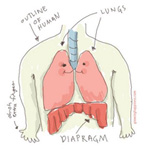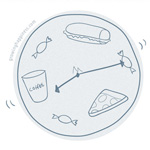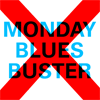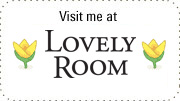Natural Polyphasic Sleep Pattern
I’ve fallen into a biphasic/polyphasic sleep pattern the last couple of months. I didn’t plan this but it seems to be doing me a lot of good so far. A weekday may go something like this:
9pm-4am (7hr): Work
4am-8.30am (4.5hr): Sleep
8.30am-4pm (7.5hr): Work + Nap (90min-3hr)
4pm-9pm (5hr): Home (family time, cooking, cleaning)
I usually sleep 4.5 or 6 hours straight for my main sleep period. The total number of hours for this is usually in multiples of 90 minutes, which is a unit of my sleep cycle (in case you’re wondering, I wake up to a giant Ikea clock so it’s really easy to tell the time). To wake up at the end of one of these 1.5-hour cycle is ideal – I’ll feel well rested and will wake up without any grogginess.
The duration of my nap in the day depends on how much I got for my main sleep period at night. I wake up mid-cycle during my naps a little more often than my main sleep period because of phone calls.
The best day (feeling full of energy, brimming with ideas, very productive) I had this week was polyphasic that went like this:
6am-9am (3hr): Sleep
9am-1pm (4hr): Work
1pm-4pm (3hr): Sleep
4pm-9pm (5hr): Home
9pm-10.30pm (1.5hr): Sleep
10.30pm-5am (6.5hr): Work
5am-10am (6hr): Sleep
Getting used to Biphasic or Polyphasic Sleep Pattern
A divided sleep pattern may or may not be for you. Many people I know are satisfied and perform well with the usual monophasic sleep pattern. If you are one of these people, I don’t see why you need to change your sleeping habits. But if you are like me, always struggling to stay at my peak performance level in throughout the day, then this is worth a shot.
People starting on a biphasic sleep routine may experience extreme sleepiness during the first few days. I think, and this is not supported by any research, it is better to gently ease yourself into it instead of forcing yourself to conform to a fixed time. Everyone is different and you know your own body best, so it’s difficult to follow someone else’s sleep routine with the same amount of success they had.
Here’s a suggestion (again, this is just a suggestion, you know your body best). You can start by identifying how long is your sleep cycle is (do this on a weekend or when you’re not working). Then reduce the amount you sleep at night by one sleep cycle (if you are currently doing 5 cycles of 90 minutes, try 4 x 90 instead). You will find that some time in the middle of the day you need to take a nap, go ahead. I do not set a specific time I need to be asleep/wake.

Benefits of Polyphasic Sleep
Higher energy/More productive hours
One of the main benefits is that my alertness level is on an all-time high. That dip in the middle of the day is now replaced by a reviving nap. I had also long suspected I’m a nocturnal worker and this is proven true in the current system — I’ve accomplish so much more (completed nearly twice normal workload) during the main work shift at night. I’ve also managed to sneak in a couple of minutes of workout daily now. So for people who have the tendency to feel sluggish in the middle of the day or who work best in the quiet of night, you may wanna try biphasic or polyphasic sleep.
Less stress
Dividing my work day into two shifts has yielded incredible results. I feel less stressed about work in the day. I like to do a lot of planning and brainstorming before delving into the actual work stuff so to know that I have another shift at night is great. It’s like I have an additional work day every day.
Improve international relations (!!!)
I respond to clients from different time zones more promptly now because I am working “round the clock”. I can see full-time bloggers taking advantage of this system, especially when you audience is a few GMT hours ahead or behind you.

When Biphasic or Polyphasic Sleep Might Not Work
While Travelling
Though my current sleeping habit started when I was traveling by rail around Europe (a couple hours here and there), I don’t see a good way you can incorporate a nap into a day of sightseeing. Unless of course, you are traveling on your own RV.
When the other half is not a willing participant
To actually have long-term success with segmented sleep, one may need to sleep alone or have a partner who is willing to be on a similar sleeping pattern. Lucky for me my husband and I sleep around the same times.
Days when you need to meet multiple clients/friends
Well, your social life have to continue, right? Unless you choose exist only in the virtual world or get all your friends and family into this.
You work in an office/outdoors/need to stick to certain work hours
A few offices have introduced power naps to increase productivity of their staff but overall but this is still not the norm.

Notes
- I don’t have an alarm clock set unless I have an appointment. When I feel sleepy, I just go to bed, when I have enough rest, I’ll naturally wake up.
- I have a cup of coffee on weekdays, anytime from 10am-4 pm. It doesn’t seem to affect my naps.
- I usually adopt a monophasic sleep pattern on Saturdays because I am out and about doing stuff. I zonk out after lunch but this is fixed with an espresso.
- Before this I usually sleep about 7 hours at night. I bought into the believe that 7 or 8 hours of sleep is the ideal time for an adult human and set my alarm accordingly. I didn’t know much about sleep cycles then. 7.5 hours is ideal for me but that doesn’t stop me from feeling drowsy in the middle of the day.
- I have been having more lucid dreams these past few weeks. In one of the dreams, I made Daniel Craig meet me in Thailand. In a tux. As James Bond. And then we built a school for disadvantaged kids. Ahem!
Start Up
Sadly, my computer hard disk died on me last week.
Luckily I have back ups done for my client work on a regular basis but 6+ years of personal stuff – sketches, ideas, plans, stories, etc – are all gone.
When I fired up my email application yesterday, my inbox was empty. I’ve lost all my emails too.
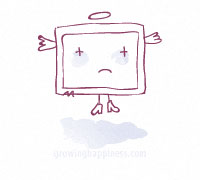
A similar event happened to me a few years ago.I used to have backups of all my work on Zip disks then (does anyone remember those blue disks?). When my then PC got corrupted beyond repair, I didn’t really worry because thought I could rely on the backup data on my zip disks. But no – ALL the disk were corrupted and unreadable. 5 years of work gone. ;(
I have to admit there’s a certain amount of liberation, starting on a clean slate. But I’m a little worried about data preservation at the moment. Will my data DVDs last? If they do will there still be DVD readers in future? Do I need to transfer my files onto a new hard disk every few years? Do I need to upload all 89 million terabytes of my digital photos to Flickr? Should I carve my ideas in stone? Or blog every tiny detail of my life online? Hmmm…
Things to Do on a Fine Day
Do you keep a “One Fine Day” list? I do.
It all started when I realised that my husband and I tend to put doing some things off till “one fine day” — see the polar bears at the zoo? Not today, maybe one fine day; one fine day we’ll watch Citizen Kane; today I don’t feel like checking out that new place, maybe another day, when the weather is fine.
I’ve started keeping a list on my computer called “One Fine Day” where I jot down activities we promise to do well, one fine day.
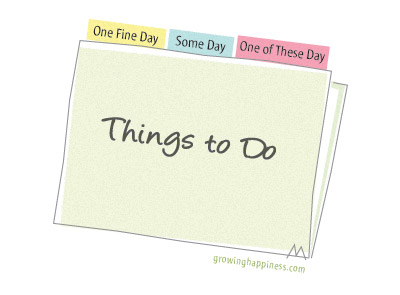
Of course life is best enjoyed without (much) planning but if we’re ever stumped with what to do on a fine, sunny Saturday, there’s always the list to refer to. So far, we’ve not yet find a need to do so but that’s also fine with me!
Useful Things in My Wallet
A Pen and A Measuring Tape
A Mini Wallet Pen
I have a mini stainless steel pen that fits nicely in my wallet (I have a Zebra one which costs about $3). My PalmPilot days probably initiated this habit. The PDA came with a stylus+pen which I used regularly (the pen, not the PDA). I no longer use a PDA, relying solely on my phone’s organiser functions, but there are many benefits to having a pen with you at all times:
- Reduce waiting time Very useful for filling in forms at the bank or contest entries at the supermarket — you don’t have to wait for the counter pens to be free or be faced with pens that run out of ink after writing the first letter.
- Make new friends There will always be someone you who’d want to borrow a pen – at a busy conference, in the plane, etc. Ran out of business cards? Just write your details on a scrap of paper and voila instant business card!
- Never lose an inspired thought The back of my receipts are filled with notes written at the point inspiration struck — ideas for design and writing, thoughts on world domination. I also write down questions to Google later when I’m at my PC.
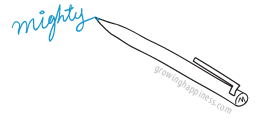
A Measuring Tape
I also have a measuring tape in my wallet. What kind of tape fits in a wallet? The paper tape measure from Ikea! It’s free, light and can fit in most wallets (you can cut half away to fit smaller wallets). What can you do with it? Let’s see:
- Reduce disagreements and inaccuracies I find it especially useful when needing to communicate the exact size of posters with my clients when I’m called to an out-of-office location. Tip for designers – mark standard paper sizes on the tape, then you’ll never have to guesstimate how wide an A2 sheet is.

- Make new friends Everyone needs to measure something now and then right? But who’d thought of carrying a tape measure with them all the time? Sure, if you’re a real estate agent, otherwise you’re probably be the one of the few people around with a portable ruler. That may earn you a friend or two.
- Never lose the opportunity to experiment Are yard-long beans really 3-feet long? Nope. Are Subway’s Footlong sandwiches exactly 12-inches long? Sometimes. Is your definition of “1 inch” different from the hairdresser’s? Yes.
Apart from the obvious (cash, cards, etc) what interesting or useful things do you have in your wallet?
Escalating Hiccup
Stretching and Other Tried and Tested Ways to Stop Hiccups
I’ve never been excited about getting hiccups before but after receiving so many responses for The Best Cure for Hiccups, I actually look forward to getting one so that I can try some of the reader-suggested methods for stopping this common problem! I I’ve got hiccups three times since.
First Time Lucky
 The first one struck about a month ago, while I was on an escalator at a shopping mall. As I didn’t have a glass of warm water handy, I decided to try one of the “mind over matter” techniques — hiccuping on command. Interestingly, right the hiccups stopped by the time I reached the next floor. It could be one of those short hiccups so I thought I’d wait for another one before blogging about it.
The first one struck about a month ago, while I was on an escalator at a shopping mall. As I didn’t have a glass of warm water handy, I decided to try one of the “mind over matter” techniques — hiccuping on command. Interestingly, right the hiccups stopped by the time I reached the next floor. It could be one of those short hiccups so I thought I’d wait for another one before blogging about it.
![]()
I Bet You Can’t Hiccup When I Tell You To
 The second incident happened last week while I was on an escalator at another shopping centre. I practiced the same thing I did a month ago but this time, it didn’t work.
The second incident happened last week while I was on an escalator at another shopping centre. I practiced the same thing I did a month ago but this time, it didn’t work.
B, who was with me at that time, tried the “fright tactic”, which did nothing to stop the spasming (but I did get a good scare). He then tried the betting as suggested by David (a variant of hiccup on command technique):
“The best cure for hiccups I’ve ever found was introduced to me by my boss. I was hiccuping and he pulled $20 out of his wallet and said, “If you can hiccup again you can have this money.” As soon as I started to concentrate on being able to hiccup they stopped. I now pull this trick on all of my friends, and I’ve never lost the bet!”
Unfortunately, he lost the bet. :P
I am Human, Therefore I Shouldn’t Hiccup?
7 minutes later, it became obvious that it wasn’t going to be a brief episode. I remembered reading the remnants of evolution theory for hiccups. In this hypothesis, it is suggested that these involuntary spasms of the diaphragm are triggered by electric signals generated in the brain stem we inherited from our amphibian ancestors. The proposed cure is to remind ourselves that we’re human. Right… I’m not too sure about the deep-sea culture 500 million years ago, but escalator-riding seems like a very human activity to me, which was what I was doing when I got my hiccup. Still, I had ran out of options so it was worth a shot.
I started thinking about all the things that made me human — surfing the internet, going to the supermarket, cycling at the beach, dining on a seafood buffet…mmm…fish.
Apparently, reminding myself that “I am NOT an amphibian…” was about as helpful as asking people to not think of pink elephants. I had more thoughts about salamanders in that two minutes than in all my school years combined. Needless to say, it didn’t do much to solve my problem (the hiccups only stopped when I was about to get myself a cup of hot tea a few minutes later).
![]()
Temporarily Not Human Again
 The third time happened five days ago while I was going down an escalator at the convention centre. Okay, I wasn’t really riding the escalator, I was descending a flight of temporary stairs but what are the odds of getting another one while being on an escalator!
The third time happened five days ago while I was going down an escalator at the convention centre. Okay, I wasn’t really riding the escalator, I was descending a flight of temporary stairs but what are the odds of getting another one while being on an escalator!
Once again I tried a few of the suggested tips:
- Holding my breath for as long as possible
- Pressing on my eyes while hitting my back
- Gasping a few times in between hiccups
- Swallowing a couple of times before hiccuping
- Twisting my earlobes
Yes, I looked very silly doing all the above, and no, none of them worked.
Stretching It A Little
I was wondering whether there was such a thing as an escalator allergy when the idea of stopping hiccups by stretching came to mind. Some muscle cramps are relieved by stretching so this suggestion seemed like a very valid one.
I didn’t remember exactly how the stretch should be done so I just pulled my left arm at an angle over my head (like this). Only half expecting it to work, I kept that position for about 10 seconds. Nothing happened.
I tried it again with my right arm, this time a little longer and stretching as far as I could. Surprisingly, the hiccups did stop!
![]()
So there you have it, some warm waterless tips tried and tested. It would be too early to say that the stretching method is the cure for hiccups (it’s only been successful with me once) but if it were, it won’t only be the best, it will be the simplest one as well! I am looking forward to my next hiccup to verify whether the result is repeatable.
Escalators, here I come!
Reboiling Points
Boiling Water Multiple Times Not As Harmful to Health As Thought
There was an elderly tea lady (let’s call her Mrs D) at the place I used to work. She wasn’t a tea lady in the traditional sense who’d wheel her trolley of goodies at teatime — she prepared refreshments for our weekly meetings — but she loved observing me while I brew a cuppa in the office pantry, which made me slightly nervous at times.
I was about to make myself a cup of instant coffee one day when I found the electric kettle filled with enough water to make a warm cup of coffee. Because of the ridiculous subarctic temperature of the office, I preferred my coffee tongue-scalding hot so I did what I thought was the obvious thing to do — I turned the kettle back on.
 Already anxious by her mere presence, I was startled silly when Mrs D boomed, “What on earth are you doing?! Why are you boiling the water again? You’re not supposed to do that!”
Already anxious by her mere presence, I was startled silly when Mrs D boomed, “What on earth are you doing?! Why are you boiling the water again? You’re not supposed to do that!”
I told her about my coffee temperature preference but she continued disapprovingly, “but you’re not supposed to reheat water that’s already been boiled!!!” When I tried asking her the reason why she kept saying that I wasn’t supposed to. I asked another colleague who happened to be there and she said the same thing, “you’re not supposed to boil water multiple times because it’s not good for you!!!”
Outnumbered with no desire to argue, I left the scene with a less-than-hot cup of coffee.
Being the naturally curious person that I am, I decided to ask the rest of my colleagues about this. The consensus was nearly unanimous(a few had never heard of it) — you shouldn’t boil water more than once — the reasons were similar – reboiled water is not good. Why exactly? They didn’t have an answer.
I wasn’t convinced and brushed it all aside as old wives’ tales. However, despite my numerous make-coffee-while-no-one-is-around attempts later, I kept forgetting to research the reasons and origins for this theory.
![]()
5 years later
I was at a coffee house while waiting for my camera to be serviced the other day when out of boredom, I decided to read all their coffee and tea leaflets. There was a section devoted to the importance of using fresh water for brewing coffee and tea. I didn’t think much about it until much later when I was making meyself a cup of coffee at home.
Remembering the Water Mystery from half a decade ago, I consulted my friend Google: Reboiled water causes cancer? – not true unless your water is already toxic to begin with. Reboiling causes water to harden? – not true either. Then I found this:
10 Tips for A Better Cup of Tea
The more oxygen that is dissolved in water, the better it tastes. So, to make sure you use water with the maximum amount of oxygen, don’t re-boil any leftover water in your kettle. Water that is boiled too much becomes poorly aerated because oxygen atoms escape in the form of steam. By always filling your kettle up afresh, you are ensured fully aerated and tasty water.”
Ten Tips for a Betta Cuppa-Fresh Water, Best water MSN Encarta
Mystery solved.
Edit: Thanks to the comment by Mihai, I suddenly remembered learning about water aeration in school. Here’s a bit more on that:
“Aerated water is, correctly speaking, distilled water to which purified air is added to improve its flavor. Wikipedia”

